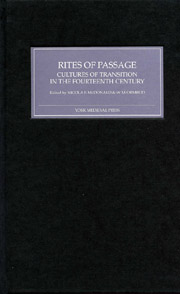Book contents
- Frontmatter
- Contents
- List of Contributors
- Preface
- Introduction: Rites of Passage
- Re-writing a Rite of Passage: The Peculiar Funeral of Edward II
- Coming to Kingship: Boy Kings and the Passage to Power in Fourteenth-Century England
- Boy/Man into Clerk/Priest: The Making of the Late Medieval Clergy
- Manners Maketh Man: Living, Dining and Becoming a Man in the Later Middle Ages
- Rites of Passage in French and English Romances
- Becoming Woman in Chaucer: ‘On ne naît pas femme, on le meurt’
- John Gower's Fear of Flying: Transitional Masculinities in the Confessio Amantis
- ‘Le moment de conclure’: Initiation as Retrospection in Froissart's Dits amoureux
- Index
- YORK MEDIEVAL PRESS: PUBLICATIONS
Becoming Woman in Chaucer: ‘On ne naît pas femme, on le meurt’
Published online by Cambridge University Press: 12 September 2012
- Frontmatter
- Contents
- List of Contributors
- Preface
- Introduction: Rites of Passage
- Re-writing a Rite of Passage: The Peculiar Funeral of Edward II
- Coming to Kingship: Boy Kings and the Passage to Power in Fourteenth-Century England
- Boy/Man into Clerk/Priest: The Making of the Late Medieval Clergy
- Manners Maketh Man: Living, Dining and Becoming a Man in the Later Middle Ages
- Rites of Passage in French and English Romances
- Becoming Woman in Chaucer: ‘On ne naît pas femme, on le meurt’
- John Gower's Fear of Flying: Transitional Masculinities in the Confessio Amantis
- ‘Le moment de conclure’: Initiation as Retrospection in Froissart's Dits amoureux
- Index
- YORK MEDIEVAL PRESS: PUBLICATIONS
Summary
This essay considers the different relations between female characters, ideals of femininity, and death in two poems by Chaucer, the Book of the Duchess (hereafter BD) and the Legend of Good Women (hereafter LGW). My argument on BD will be a version of that line of criticism which sees the poem as a funerary monument to the lady; the anthropological model here presented enhances understanding of this aspect of the poem. The absence in LGW of such a close fit between theory and text is itself productive, enabling us at once to refine the anthropological model and to argue that LGW works against certain normative constructions of femininity exemplified in BD. My focus will be on one specific rite of passage: that by which a deceased person is detached from the community of the living and integrated into the community of the dead. In both BD and LGW this process relates to a female character idealized as feminine exemplar. Hence my subtitle, which derives from the opening line of volume two of Beauvoir's Le deuxième sexe: ‘on ne naît pas femme, on le devient’, which I gloss as ‘it is not birth that produces a woman, but social and cultural life’. My adaptation is intended to read: ‘it is not birth that produces a woman, but social and cultural death’. In BD the lady's idealization depends on her laudable willingness to leave the land of the living for that of the dead, whereas the virtuous women of LGW take their stand in an intermediate zone between earthly and heavenly life, resisting both passage into the afterlife and the rites designed to facilitate it.
- Type
- Chapter
- Information
- Rites of PassageCultures of Transition in the Fourteenth Century, pp. 109 - 130Publisher: Boydell & BrewerPrint publication year: 2004



